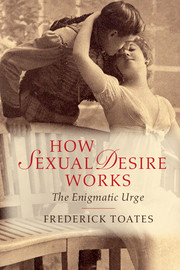Book contents
- Frontmatter
- Dedication
- Contents
- List of figures
- Preface
- One What is enigmatic about sexual desire?
- Two Explaining desire: multiple perspectives
- Three Sexual desire in a broad context
- Four An incentive-based model
- Five Sex and levels of organization
- Six Sexual attraction
- Seven Shades of desire from simple to complex
- Eight Details of the brain and desire
- Nine Arousal
- Ten The consequences of sexual behaviour and associated expectations
- Eleven Sexual familiarity and novelty
- Twelve Inhibition, conflict and temptation
- Thirteen How did sexual desire get here?
- Fourteen Setting the trajectory: link to adult sexuality
- Fifteen Sexual desire in interaction
- Sixteen Representations of sex
- Seventeen Sexual addiction
- Eighteen Variations in desire: general principles
- Nineteen Some forms of desire at the fringes
- Twenty The toxic fusion: violence and sexual desire
- Twenty one Sexually associated (serial) murder
- Twenty two Concluding remarks
- Notes
- References
- Index
Eight - Details of the brain and desire
Published online by Cambridge University Press: 05 October 2014
- Frontmatter
- Dedication
- Contents
- List of figures
- Preface
- One What is enigmatic about sexual desire?
- Two Explaining desire: multiple perspectives
- Three Sexual desire in a broad context
- Four An incentive-based model
- Five Sex and levels of organization
- Six Sexual attraction
- Seven Shades of desire from simple to complex
- Eight Details of the brain and desire
- Nine Arousal
- Ten The consequences of sexual behaviour and associated expectations
- Eleven Sexual familiarity and novelty
- Twelve Inhibition, conflict and temptation
- Thirteen How did sexual desire get here?
- Fourteen Setting the trajectory: link to adult sexuality
- Fifteen Sexual desire in interaction
- Sixteen Representations of sex
- Seventeen Sexual addiction
- Eighteen Variations in desire: general principles
- Nineteen Some forms of desire at the fringes
- Twenty The toxic fusion: violence and sexual desire
- Twenty one Sexually associated (serial) murder
- Twenty two Concluding remarks
- Notes
- References
- Index
Summary
For suddenly he was aware of the old flame shooting and leaping up in his loins, that he had hoped was quiescent for ever.
(D. H. Lawrence, 1928/1993, p. 120)Swelling detected at the genitals appears to add to desire arising from the stimulus of a potential partner (Georgiadis et al., 2012) and might even provide the principal stimulus to desire (Laan and Both, 2008). Positive feedback seems to be involved (Mouras et al., 2008); in response to a visual stimulus, desire would contribute to genital arousal and, by means of signals from the genitals to the brain, there would be an amplification of desire.
The bits that make up the whole
Knowledge of the brain bases of desire comes from several sources (Chapter 2):
research on non-humans and cautiously extrapolating to humans;
looking at changes in the sexual desire of people following brain damage or disease;
using neuroimaging to examine activity in the brains of people exposed to erotic images.
Neuroimaging reveals a network of interacting brain regions, parts of which are excited and others of which are inhibited by erotic visual stimuli (Georgiadis et al. 2010; Redouté et al. 2005). Researchers distinguish regions serving some closely related but nonetheless somewhat conceptually distinct roles:
to make an initial assessment of the sexual value of the content of the image;
to produce a signal that is sent to the genitals to trigger swelling;
to receive feedback from the genitals on their arousal – this signal is thought to contribute to the conscious awareness of the state of the body, particularly the dimension of eroticism;
to create a motivational signal, having unconscious and conscious aspects, which tends to direct behaviour towards the sexual stimulus – a feature of this is conscious desire.
- Type
- Chapter
- Information
- How Sexual Desire WorksThe Enigmatic Urge, pp. 145 - 163Publisher: Cambridge University PressPrint publication year: 2014



